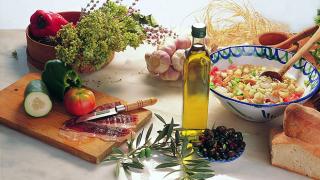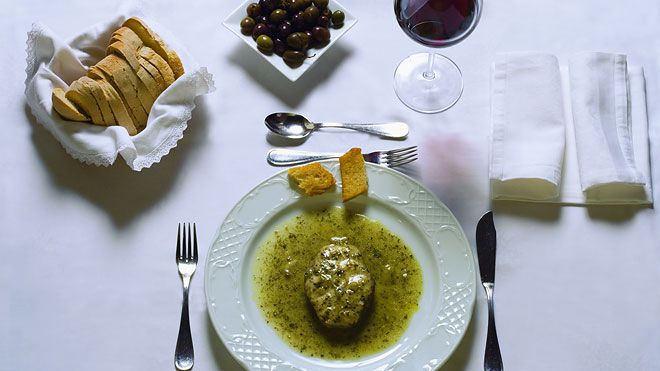Creativity and imagination in using very simple ingredients has made Alentejo cuisine a surprising mix of flavours and proof of the hospitality of the Alentejo people.
The province was once a region of wheat and wide plains where herds of swine grazed freely in oak plantations and olive groves. Bread, pork and olive oil therefore became staples in one of the tastiest cuisines in Portugal, seamlessly combined with aromatic herbs such as coriander, parsley, rosemary, oregano, pennyroyal and mint.
One of the regional delights is the small dishes of tidbits. Whether as a starter or for tasting the specialities, scrambled eggs with wild asparagus, grilled peppers, pork crackling or migas (sautéed breadcrumbs and garlic) of various flavours and in various combinations are irresistible.
Soup, which can be the main course, is a must. It may be a gazpacho, served cold, or a dogfish, cod, or tomato and sausage soup, made with bread. The soup that you absolutely have to taste is the simplest of them all: açorda Alentejo style, made with water, olive oil, garlic, a poached egg, bread and coriander. Also made from bread are the migas which accompany fried pork or shredded cod, for example.
On the coast, it’s worth trying fish fresh from the sea or other specialities, such as barnacles or dishes with clams, such as Alentejo-style pork.
Creativity and imagination in using very simple ingredients has made Alentejo cuisine a surprising mix of flavours and proof of the hospitality of the Alentejo people.
The province was once a region of wheat and wide plains where herds of swine grazed freely in oak plantations and olive groves. Bread, pork and olive oil therefore became staples in one of the tastiest cuisines in Portugal, seamlessly combined with aromatic herbs such as coriander, parsley, rosemary, oregano, pennyroyal and mint.
One of the regional delights is the small dishes of tidbits. Whether as a starter or for tasting the specialities, scrambled eggs with wild asparagus, grilled peppers, pork crackling or migas (sautéed breadcrumbs and garlic) of various flavours and in various combinations are irresistible.
Soup, which can be the main course, is a must. It may be a gazpacho, served cold, or a dogfish, cod, or tomato and sausage soup, made with bread. The soup that you absolutely have to taste is the simplest of them all: açorda Alentejo style, made with water, olive oil, garlic, a poached egg, bread and coriander. Also made from bread are the migas which accompany fried pork or shredded cod, for example.
On the coast, it’s worth trying fish fresh from the sea or other specialities, such as barnacles or dishes with clams, such as Alentejo-style pork.
Much appreciated and renowned as well are the cheeses from the three producing regions - Nisa, Serpa and Évora. These are sheep’s or goat’s cheeses, which may be dry, half cured or creamy, and they combine extremely well with the wines from the Alentejo demarcated region, such as the reds from Portalegre, Borba, Redondo, Reguengos, Vidigueira and Moura. However, if you are keen to know them, the best would be to follow the Alentejo Wine Route.
At the end, there will still be room to delight yourself with a dessert - you can even take a gastronomic tour of them! In Évora, you will discover pão de rala (sweet made with eggs, sugar and angel hair), toucinho-do-céu (sugar and egg yolk sweet, originally made with lard), morgados (small cakes made with sugar, almond, eggs, angel hair and pumpkin) and queijadas (cheese cakes); in Alcácer do Sal, you must taste pinhoada (pinenut-based sweet); and in Beja, trouxas-de-ovos (sugar and yolk-based “egg bundles”), Santa Clara pastries, tosquiados (cakes made with egg whites, sugar and dried fruits) and curd cheese cakes are a must.
But there’s still the Vidigueira almond cake, the Vila Viçosa tibornas (cakes made with eggs, sugar, almonds and pumpkin) and filhós enroladas (light pastry fritters), the Monforte toucinho rançoso (a dense, wet almond and pumpkin-based cake), the Castelo de Vide boleimas (cake made with an unleavened bread dough with sugar, apple jam and nuts), the Sines areias (small, dry cakes made with eggs, sugar, pumpkin and almond), the Monforte honey cakes, the Crato mimosos (round cakes topped with meringue), the Avis cavacas (small iced, brandy-flavoured cakes)… And if you pass through Elvas or Vila Viçosa, you will not be able to resist sericaia. It is a truly Alentejo dessert, which combines eggs, milk, sugar and cinnamon to perfection and, if you’re lucky, has been baked on a tin dish, as tradition has it. It is accompanied with one or two juicy Elvas prunes dripping with syrup.
Although this is good advice for the whole country, in Alentejo eating with the seasons seems to make more sense, since the freshness of the produce brings out the flavours and secrets of the traditional gastronomy.
While in summer grilled fresh fish and seafood from the coast tastes good and cold gazpacho is refreshing, in winter you can take comfort from fried pork with migas. In spring, bread soup and lamb casserole or river fish are just right. And in autumn, sausages and game dishes, such as rabbit, partridge or boar, deserve pride of place.
The truth is that you will always be welcome in an Alentejo home, because the table is forever set for friends and good conversation always goes with a bite to eat.













 Explore
Explore 




 Remember and Share
Remember and Share 


